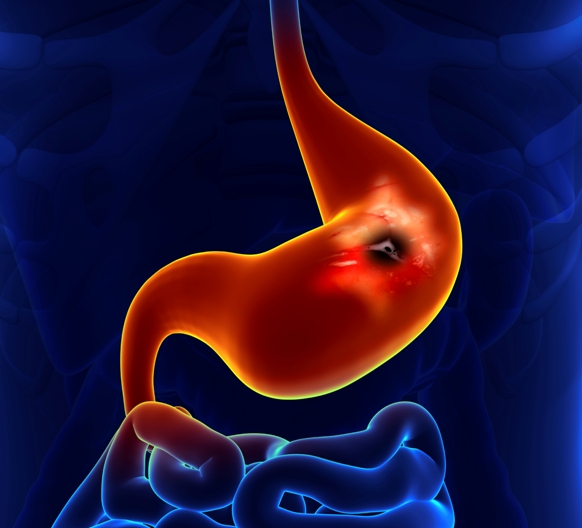Personalized Light-Based Diagnosis of Stomach Cancer
Personalized medicine, also called precision medicine, is an individualized approach to disease, one that takes into account each individual’s unique biology. Not surprisingly, because every cancer arises from the body itself, every cancer is as unique as the individual who harbors the disease. Personalized medicine depends on the use of precise diagnostic tests and targeted therapies that are tailored to the individual with the goal of optimizing the treatment outcome.
It makes good sense that scientists interested in personalized medicine would also be interested in photodynamic diagnosis. This light-based approach to diagnosis uses a photodynamic agent, such as 5-aminolevulinic acid (5-ALA), in order to “light up” areas of disease within the body. Within the body, 5-ALA is converted into protoporphyrin IX, a natural photosensitizer that fluoresces or emits a reddish “glow” upon exposure to blue light.
The use of 5-ALA-based photodynamic diagnosis (5-ALA-PDD) has already demonstrated sufficient safety and efficacy for a number of cancers. One reason this approach has received so much attention in recent years is that it allows for rapid detection of malignant tumors and lesions during the surgery. In essence, this enables the surgeon to better see how much tissue needs to be removed during the operation.
A Review of the Evidence
Researchers from the Kyoto Prefectural University of Medicine in Kyoto, Japan, recently sought to determine the feasibility of 5-ALA-PDD for people with stomach cancer (also known as gastric cancer). They reviewed studies of PDD for humans and animals harboring this cancer. In addition to using PDD to detect the primary tumor, the scientists were interested in PDD’s potential to detect the spread of lymph node metastases in the belly area (peritoneum).
Based on their review of the medical literature, the Kyoto researchers concluded that 5-ALA-PDD enables “real-time fluorescence detection” of these lymph node metastases, showing higher sensitivity than the standard way of observing this spread of disease using white light observation. The PDD method also enables one to detect metastatic foci or “spots” within lymph nodes that have been removed by the surgery.
What’s surprising is that PDD was found to have a degree of diagnostic accuracy comparable to that of current molecular diagnostic techniques, the very same techniques used in personalized medicine. The researchers also noted that 5-ALA-PDD enabled a qualitative diagnosis of superficial liver metastases.
“In the field of gastrointestinal cancer treatment, 5-ALA-PDD has been used for the in vivo detection of peritoneal dissemination in patients with advanced gastrointestinal cancer,” the Kyoto researchers write in the 21 January 2016 World Journal of Gastroenterology. “In addition, the feasibility of using 5-ALA-PDD to detect lymph node metastases is now being validated in clinical trials. Although several complicating issues still need to be resolved… this simple and rapid method has the potential to become a useful diagnostic tool for gastric cancer, as well as urinary bladder cancer and glioma [brain tumors].”
Less Sensitivity to Light
When a photosensitizer is administered, the patient typically is advised to avoid excessive light exposure in order to minimize the risk of developing skin photosensitivity (rashes and irritation of the skin in response to light). This is a major problem with certain photosensitizers, such as Photofrin and Laserphyrin, both of which require avoiding sunlight or bright light exposure for weeks.
Thankfully, however, such diligence is not needed in the case of 5-ALA, since the light sensitivity disappears within just a few hours. The Kyoto team reports having performed 5-ALA-PDD for over 100 patients with gastrointestinal cancers in clinical trials. To date, they have observed no adverse effects, such as phototoxic skin or liver problems.
Photodynamic diagnosis, also called fluorescence diagnostics, could pave the way for far more successful cancer treatment outcomes in the future, especially when combined with surgery and photodynamic therapy. “Fluorescence diagnostics offer real-time visualization with high sensitivity unsurpassed by other diagnostic tools,” the authors write. “With further technical development, application of 5-ALA-PDD is expected to become more widespread in gastric cancer treatment.”
Sources
Koizumi N, Harada Y, Minamikawa T, Tanaka H, Otsuji E, Takamatsu T. Recent advances in photodynamic diagnosis of gastric cancer using 5-aminolevulinic acid. World J Gastroenterol. 2016 Jan 21;22(3):1289-96
Chen J, Mao L, Liu S, Liang Y, Wang S, Wang Y, Zhao Q, Zhang X, Che Y, Gao L, Liu T. Effects of a novel porphyrin-based photosensitizer on sensitive and multidrug-resistant human gastric cancer cell lines. J Photochem Photobiol B. 2015 Oct;151:186-93.



 English
English Français
Français Deutsch
Deutsch Nederlands
Nederlands